Performance
Format
CompressionThe biggest news about the new JVC HD Everio is that it compresses video using a new "MPEG-2 Transport Stream" developed by JVC. It is unlike any system on the consumer market to date. The HD7 uniquely employs VBR (variable bit rate) encoding at up to 30Mbps with an average speed of 26.6Mbps. This compression rate leapfrogs AVCHD MPEG-4/H.264 compression, which has a theoretical max data rate of 24Mbps, but is currently implemented at a max of 15Mbps on Sony’s HDR-SR1. With so little information about MPEG-2 Transport Stream technology available at the time of this review, we can only speculate on the implications of what this new 30Mbps compression will produce, and how its efficiency compares to AVCHD. The question of whether JVC’s new algorithm will match or exceed HDV video quality (also an MPEG-2 format) in an HDD-based camcorder is certainly on our minds. In addition to its highest quality setting, the HD7 includes a SP mode that captures video at 1440 x 1080i resolution and a variable bit rate 22Mbps maximum and 19Mbps average, as well as a constant bit rate mode of 1440 x 1080i at 27Mbps. The Full HD high quality mode can store five hours worth of video to the 60GB HDD while the SP, Long Time Mode records about seven hours to the HDD. JVC is closely guarding most of the specifications surrounding this technology. Another big selling point of the JVC HD Everio is that MPEG-2 Transport Stream video can be easily archived to Blu-ray discs. JVC will include Blu-ray DVD authoring software with the HD7, as well as playback and editing tools. Audio is compressed using a MPEG-1 Layer 2 audio compression algorithm.** ****Media**The JVC HD Everio GZ-HD7 is equipped with a 60GB built-in hard drive. Users will find that they are able to record video footage for up to seven hours with a lower variable bit rate and lower recording quality. Although perhaps necessary in a pinch, avoiding a lower-quality recording mode is advisable considering the impressive full HD capabilities. If shooting in the Full HD High quality mode, the user will able to record up to five hours of full HD 1920x1080i while recording at a maximum variable bit rate of 30Mbps(MAX) Mbps. **Editing**The JVC HD Everio GZ-HD7 comes with an attractive bundle of editing and archiving software for Windows-based PCs from Cyberlink BD Solution software suite, similar to their Cyberlink bundles in the past. This software suite contains PowerDirector for HD video editing, PowerProducer for the authoring of high definition Blu-ray discs and DVD video discs, and PowerCinema, a program that can be used both for playback and the management of image and video files. One of the major hurdles for video enthusiasts looking to make the jump to full HD content has been a lack of affordable Blu-ray software. The inclusion of Cyberlinks BD Solution suite provides a surprisingly complete end-to-end BD solution. PowerMac users will need to assemble their own solutions as the CyberLink BD Solution suite is compatible only with Intel-based Macs and even that is complicated. You must own a copy of Windows for Mac and run the program through Bootcamp.
Tour
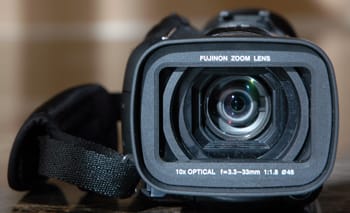
**The Front **The Fujinon f3.3-33 mm 10x optical zoom lens monopolizes the front end of the JVC HD Everio GZ-HD7. This lens includes a removable optional lens hood and accommodates 46 mm wide-angle telephoto lens adaptors. The wide, rubber manual focus ring is located directly behind the lens of the camera. Underneath the lens, on the right side of the camcorder body, is a small button labeled focus assist. This control is a feature that displays the focus margin in color while the out-of-focus portions of the frame switch to a black and white display. This is a new spin on focus assist features that should provide a particularly user-friendly manual focus aide. Focus assist features are becoming widespread on HD camcorders because HD’s increased resolution over standard definition makes it unforgiving of soft focus. This tool makes the HD7’s ring a more approachable focusing device for beginning users and experienced shooters who want to ensure their images are crisp.
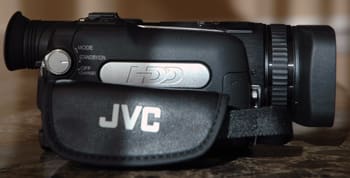
**The Right Side **The JVC HD Everio GZ-HD7 camcorder body is split into two sections with the lens on the left side and the hard disk drive bulging to the right side. The HDD is emblazoned with a silver "HDD" label. It looks as though it will fit comfortably into your right palm. A plush adjustable Velcro hand strap spans the right side horizontally and attaches to the camcorder body at the front and back edges. A switch is located directly behind the manual focus ring and the front hand strap connection point. On the other side of the hand strap connection point is a small port cover. This port cover protects the mic-in and AV-out ports. The location of the mic jack could be a problem during hand-held shooting with an external microphone given its proximity to the strap. While we have not handled the camcorder, we’ve noted this problem in the past where a mic jack too near the strap experiences stress as the strap presses against the plug. Until we see a production model this spring, it’s unclear whether this placement will hinder external mic use. Moving to the back of the camcorder, in the upper back corner, directly above the hand strap attachment is a power/mode switch. This switch has a small tab that must be depressed to toggle between off and on/standby modes. This switch is identical in design to the power switch found on the GZ-MG555.
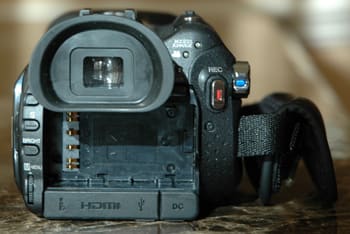
**The Back **An electronic color viewfinder graces the back of the HD Everio GZ-HD7. Unlike some other HDD cams that lack a secondary monitoring device, including more novice-friendly JVC GZ-MG555, the EVF enables users to conserve battery life and provides a usable option in bright light when LCDs become solarized. The eyepiece for the electronic color viewfinder is larger and better than most, and should do a decent job of impeding light leak. To the right of the viewfinder, on the other half of the camcorder, are three LED lights that indicate access/charge, video and still image shooting modes. Moving further to the right of these LEDs, users will find a well sized and raised, polished silver record button. This lozenge shaped button has a red center to indicate the function of this control. Beneath the record button are a series of small dots that function as a grip for the thumb of the right hand. Underneath the viewfinder, and consuming a large portion of the back face,is a battery slot. The battery slides neatly into place and protrudes out slightly from the camcorder body. Beneath the battery and running horizontally along the bottom edge of the camcorder are four ports located underneath two port covers. These covers are opened via tabs located on their bottom edge. The port cover on the left side protects the i.LINK (IEEE 1394), HDMI and USB ports. The DC IN port is underneath the port cover on the right side. These port covers are embossed with the icons for each of the connection options on their exterior surface. Four controls are positioned on the right edge of the back face and control a variety of parameters. The top two buttons are small and labeled "A" and "S" and we suspect they will engage shutter and aperture priority modes respectively on the GZ-HD7. Underneath these two controls is a button labeled "bright". A partially rotating temporary jog wheel is located near the bottom of the camcorder in a vertical position and is labeled "M-menu". This control, while obviously being able to move up and down through settings quickly, also appears depressible. We could not confirm this at CES, but it may improve upon the design of last year’s GZ-MG505.
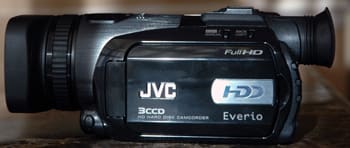
**The Left Side **The 2.7-inch LCD screen for the JVC HD Everio GZ-HD7 can be flipped out from the camcorder body either by pulling the scalloped back edge, or the top or bottom edges of the LCD frame. The LCD flips out from the body of the camcorder and rotates through the standard 270 degrees. Like the hybrid HDD/SDHC GZ-MG555, the HD7 has three control features located along the left side of the LCD screen. The top button displays access to battery/index information, while the bottom control is a push-button that opens the function menu. The center control is a joystick controller that is similar in size and design the one found on the GZ-MG555, and may present a challenge to users like myself with larger than average hands. The joystick serves as the menu navigation tool, and in recording modes, offers access to Program AE modes and night shooting mode. Underneath the LCD screen in a label indicating this is a 16:9 display. In the LCD cavity of the JVC HD Everio GZ-HD7 are a number of controls and features for the camcorder. In the upper back corner is a small rectangular button for shooting info, while the menu button is located directly beneath and identical in size and shape. Moving forward from the info button is the select play/rec button for switching between shooting and playback/review modes. Beneath the select play/rec button a direct back-upbutton, offering one-touch archiving of video content to a PC. Under these controls is a component port in the lower back corner of the LCD cavity, and a S-Video port is located in front and slightly above the component port. Above the component port is the onboard audio speaker for monitoring in playback mode. Above the LCD screen, on an angled face, between the left and top faces of the camcorder are two small controls. The back control will trigger the backlight on and off while the control to the front allows the user to switch back and forth between auto and manual shooting modes. In front of the hinge connecting the LCD to the body of the camcorder is a small button that is labeled focus. This button is likely a toggle for auto and manual focus modes.
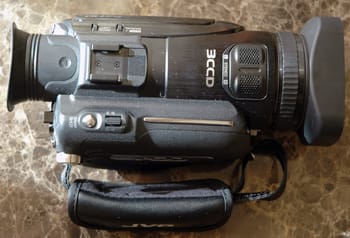
**The Top**On the top of the GZ-HD7, near the front of the camcorder, directly behind the manual focus ring is the in-camera stereo microphone. The right half of the GZ-HD7 is made from molded plastic and the grip for the right hand appears to provide a competent hold of the camcorder when shooting. A raised silver strip runs lengthwise along the ridge of the right side for extra grip. Behind the grip area of the right side is the zoom control for the camcorder. This zoom toggle has a raised lever design similar to those found on other Everios. We find JVC’s switches to be generally responsive and well-designed – better than the zoom sliders found on many Panasonic’s, but it is a touch less refined than Sony’s very nice rockers. The zoom toggle has additional control functions when not in playback mode, where it controls audio volume, display mode, and playback zoom. And finally, located directly behind the zoom toggle is the snapshot button for capturing still images. The cold shoe is positioned on the top of the lens barrel directly to the left of the zoom toggle and the snapshot button.
Auto / Manual Controls
Picture & Manual Control*Automatic Control*The JVC HD Everio GZ-HD7 has a switch on the left side of the camcorder body directly above the LCD that allows the user to move between auto and manual shooting modes. A more complete analysis of automatic controls and features will occur in our full length review of the GZ-HD7 later this spring. *Overall Manual Control While playing their cards close to the chest, JVC indicated that the HD7 will feature an extensive manual control suite. JVC typically ranks second behind Panasonic on the consumer camcorder market in terms of the range of manual image controls offered on their consumer cams. We expect to see a suite that at least matches the top-end standard definition GZ-MG555. That camcorder offers manual control over focus, exposure, aperture, shutter speed, white balance, and gain. JVC’s people imply that the list of manual controls and the interface for the HD7 will be more robust than this. However, with so much unknown about this enigmatic model, definitive information is yet to come. A major appeal for many consumers beyond the technology is the inclusion of a manual focus ring located directly behind the lens hood of the camcorder. With Sony dropping a ring control from a handful of their HD models this year, it leaves this JVC among a select few consumer cams boasting a ring. Manual controls that can be confirmed at this time include exposure, aperture, shutter speed, and gain. *Zoom*The JVC HD Everio GZ-HD7 camcorder is equipped with a broadcast quality Fujinon 10x optical zoom lens. This partnership with a third party manufacturer is a first in JVC’s consumer camcorder unit, and we look forward to observing the lens’ performance in our testing room. For users concerned with camera shake, this will also include OIS (optical image stabilization). This is an upgrade over the GZ-MG555’s digital image stabilization. We were not able to handle the camcorder during CES, but the zoom control found on the top of the camcorder body appears to be similar if not identical to the toggle found with the GZ-MG555 and should function similarly. *Focus *For video enthusiasts who long for real control over manual focus when shooting footage, the JVC HD Everio GZ-HD7 should be appealing. Our readers immediately took notice about the inclusion of the manual focus ring when the HD7 was announced. We see this as a step in the right direction when many camcorder manufacturers are stripping even their higher end models of controls and settings that the manual junkie finds essential. In addition to the manual focus ring, the JVC HD Everio GZ-HD7 comes with a focus assist button that is located on the front face of the camcorder. This button, when activated, will display the elements in focus in color, while the rest of the image will be displayed as black and white. This feature does not affect the final video footage and should help users to keep their 1080i image sharp during manual focus adjustments. Exposure & Aperture The JVC HD Everio GZ-HD7 will have manual control over both aperture and exposure. A small button on the back of the camcorder to the right of the viewfinder is labeled "A" and may access aperture-priority mode. The camcorder has a maximum aperture of f/1.8 in wide-screen mode. JVC reports that f/1.8 can be maintained throughout the length of the zoom range because of the use of three aspherical lens elements – a considerable benefit for telephoto shooting when most non-professional lenses experience a drop in exposure. *Shutter Speed*Manual control over shutter speed, like aperture, featured on the JVC HD Everio GZ-HD7. The shutter priority mode appears to have it’s own button located directly beneath the aperture priority button located on the back of the camcorder body. This button is labeled with the letter "S" and is prominently placed, a smart move given that its likely to be an oft-used control. The shutter speed range for the less expensive GZ-MG555, also announced this week in Las Vegas, is 1/2 second to 1/4000 of a second and we expect to see a comparable range on this more-expensive camcorder. White Balance*The JVC HD Everio GZ-HD7 does come with a manual control over white balance. While an auto white balance and preset white balance modes should be included with this camcorder, JVC representatives are unable to discuss specific modes for the camcorder at this time. *Gain*While no information is currently being provided regarding manual control over gain, we know some kind of gain control will be provided. The GZ-MG555, a hybrid camcorder priced just under nine-hundred dollars, was announced by JVC this week in Las Vegas and is equipped with the same rudimentary Gain Up on/off option found on last year’s GZ505. Our hope is that JVC will expand gain options to include independent control over gain levels – something that only Panasonics currently offer consumers. *Other Manual Controls*JVC was unable to comment officially regarding additional manual controls that may be included with the JVC HD Everio GZ-HD7. With an MSRP of around $1800, a broadened manual control suite is certainly possible.
Still Features
**Still Features **The still features for the JVC HD Everio GZ-HD7 are still a bit vague, but we do know is that users will be able to capture still images to the HDD. The mode switch on the right side of the camcorder body appears to function in the same manner as the one found on the JVC Everio GZ-MG555 and should switch the camcorder between video and still image shooting modes. When shooting in still image mode, users will be able to capture photographs by pressing the snapshot button located on the top of the camcorder body directly behind the zoom toggle. We do not know whether the HD7 will offer simultaneous image capture option, but it is plausible to expect this on a camcorder in this price range. Still images can also be archived to DVD using the JVC Share Station CU-VD40 that sells for about $399.95 and allows image transfer to both DVD-R and DVD-RW discs. Still images can also be shared, like video files, through the HDMI output found on the Share Station separate from the camcorder’s HDMI port. This camcorder is geared towards higher-level users than the GZ-MG555, and video/still hybrid fans may miss an in-camera flash on this model.
Handling and Use
Ease of UseWhile we can not comment on the menu system setup and navigation, we can tell you that the full text labels, sizeable controls and well-built camcorder body should enable a heightened level of functionality for both novice and advanced video users. Controls are well-spaced so users shouldn’t need to worry about accidentally triggering incorrect settings since the controls on the exterior of the camcorder are minimal, the user should be able to immediately locate and engage without hassle. It will be interesting to see what the menu system includes and how the menu is structured since there were drastic improvements between last year’s models and this years models in the Everio camcorder series. **Handling**The JVC HD Everio GZ-HD7 was carefully cordoned off throughout CES and was only handled by JVC representatives during our brief shoot. This limits our ability to discuss handling in any detail, but what we did find out through our visual examination is both a modest increase in body size over previous Everio models. There is a little concern with the placement of the ports on the right side of the camcorder body since it apears that a microphone plug could suffer from strain due to contact with the strap during hand-held shooting. Also, the zoom toggle found with this HD camcorder is similar to the one found on the Everio GZ-MG555. The focus ring is a new addition, with its wide rubber grip. We expect the HD7 to handle much like other Everios but on a slightly larger scale.** ****Menu**JVC is keeping the menu systems for the HD Everio GZ-HD7 under-wraps for the moment. With three menu buttons being placed on the camcorder body, it looks as though this model will display a revamped menu structure. Users will find a menu button on the left side of the LCD frame, in the same position as on the JVC GZ-MG555. In the LCD cavity of the camcorder, the user will find another menu button and in all likelihood this control will open the overall shooting menu for the camcorder. The third and most interesting menu control is found on the back of the camcorder body, in the lower left hand corner. This is a jog dial that can be pressed either up or down and is similar to switches found on some prosumer camcorders like Sony’s HDR-FX7, where it’s used to for menu navigation. The switch on the HD7 is labeled "M Menu" and probably has been implemented to serve a broadened control menu. As with so much else, you’ll need to wait for our full-length review for a full explanation of this suggestive feature. **LCD and Viewfinder**The LCD screen for the JVC HD Everio GZ-HD7 flips out from the left side of the camcorder body and rotates two hundred and seventy degrees. The screen measures 2.7 inches but the pixel count for the screen could not be confirmed at this time. The viewfinder for the camcorder is an electronic color viewfinder and both its size and pixel count were not available. The eyecup is generously sized for a consumer camcorder and looks like a more usable tool than the uncomfortable, marginally useful EVF’s that have become common on consumer camcorders.
Audio / Playback / Connectivity
AudioThe HD Everio records audio via either the on-camera stereo microphone positioned on the top front of the lens barrel, or via an external mic connected to the mic jack at the front right side of the body. An cold accessory shoe on the top of the camcorder can be used for attaching external microphones with a standard adaptor. The inclusion of a microphone jack is an important addition for users concerned with audio quality and is a must for any professional application. This begs the question of how good the GZ-HD7 will be and whether it will appeal to pros looking for a low-profile or second camcorder. The inclusion of the mic jack on a camcorder with both a professional grade lens and video bit rates higher than HDV suggest the HD7 may be up to the task. **Playback**Unfortunately, JVC is not releasing too much information at this time regarding playback capabilities and editing features for the JVC HD Everio GZ-HD7. What we do know is that the camcorder is equipped with S-Video, composite and AV-out ports for analog transfer of data while digital viewing and transfer can be accomplished through the use of the iLink, HDMI and USB ports located on the back of the camcorder body. Additionally, JVC has a Direct Backup feature that allows users to immediately backup the content of their camcorders hard disk drive to personal computer. Navigation and selection of footage should be easier with this non-linear format when compared to tape-based camcorders and users should be able to view footage in both a multi-up and single image format in this model.
**
Connectivity**The JVC HD Everio GZ-HD7 camcorder has a number of port options for users. On the back of the camcorder body are four ports located beneath two covers at the base of the camcorder body. These port covers open via tabs located along their bottom edge. The left port cover masks ports for USB, HDMI, and i.LINK. Most users will find the HDMI is mostly used for viewing footage digitally on HDTV and other large screen displays, while the i.LINK (aka FireWire or IEEE 1394) terminal facilitates data transfer for editing or archiving. To the right of these three terminals, and masked beneath its own cover, is a fourth port that allows the user to connect the camcorder to a DC power source. On the left side of the camcorder body are two ports located inside the LCD cavity for S-Video and composite video out. Although uncovered, these ports will be protected by the closed LCD screen when the camcorder is packed away. Finally, on the right side of the camcorder body near the manual focus ring is another port cover protecting the external mic jack and the AV out terminal. As previously noted, the location of the mic jack may be too close the hand strap during hand-held shooting.
Other Features
Other Features
***Zebra Stripes - *The JVC HD Everio GZ-HD7 will have a Zebra stripe function that can be engaged to display a striped pattern in brighter areas of the frame. Zebra stripes are a feature standard on prosumer camcorders, but rare on consumer cams.** *Conversion Lens* – The Fujinon 10x optical zoom lens can be adapted by the user of the GZ-HD7 with either a 46mm telephoto or a 46 wide conversion lens. *Everio Share Station CU-VD40* – This optional JVC DVD burner is not included with the HD Everio but can be used in conjunction with the camcorder to burn HD footage to to DVD-R or DVD-RW discs. This accessory DVD burner is also able to record digital still images in the JPEG format and record dual-layer DVD-R discs. This burner can also be used as either a playback device or as a DVD burner for PC. The station will have an initial MSRP of $399.95 and will be available in April of 2007.
Comparisons / Conclusion
ConclusionThis article contains less in the way of hard facts than most of our First Impression reviews and is much more speculative. JVC simply would not release information about the key features that piqued our interest most and was absolutely adamant that even after two days of standing and staring, photographing and scribbling notes, begging and pleading, we could not see the menu. What lies within? Golden nuggets and rainbows for all we know. In all seriousness, it's fairly easy to spot patterns within manufacturer's products. Even though this camcorder uses a new codec, the handling, manual control suite, menu interface, and overall feel will be very, very similar to its predecessors. Our experience with Everios of the past tells us that JVC focuses on simplicity, portability, and medium-grade feature set. Clearly, the feature set has been upgraded, and the body is somewhat larger than the standard definition Everios, but one look at this camcorder tells you which product line it belongs in. It is HD quality in a form you recognize and feel comfortable with - this is JVC's direction for the HD7. With three 1/5" CCDs, a 10x aspherical Fujinon zoom lens, a microphone input, conversion lenses, direct Blu-ray compatibility ,and an impressively complete bundle of editing and authoring software, this camcorder is sure to generate even more buzz than it already has. As the first consumer camcorder to shoot and record true 1920 x 1080i video, referred to by JVC as "full HD" recording, the HD7 looks to be a strong challenger in a HD market that has been dominated by Sony during the past few years. With a compact body and an understated external layout, this $1799 MSRP camcorder should appeal to shooters looking for high-performance and convenience. Though details remain shrouded in JVC’s veil of mystery, the focus ring and the added control dial suggest that there are some manual control surprises in store under the HD7’s hood. The newly developed MPEG-2 Transport Stream compression method is highly compatible with Blu-ray discs and features like Direct Backup to PC should make this a a user-friendly camcorder. The data transfer rate for this camcorder is variable, maxing out at 30Mbps with a 26.6Mbps average rate in its highest quality setting. This data rate is double the maximum currently found on AVCHD camcorders and will place the HD7 in a unique position. Of all the camcorders featured at this year’s Consumer Electronics Show for 2007, JVC’s HD7 is undoubtedly the most tantalizing.
Specs/Ratings
{{manufacturer_specs_table}}{{raw_scores_table}}
Meet the tester

James Murray
Editor
James Murray is a valued contributor to the Reviewed.com family of sites.
Checking our work.
Our team is here for one purpose: to help you buy the best stuff and love what you own. Our writers, editors, and lab technicians obsess over the products we cover to make sure you're confident and satisfied. Have a different opinion about something we recommend? Email us and we'll compare notes.
Shoot us an email